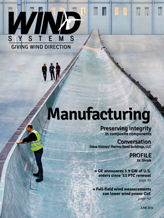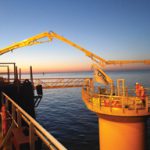Composite repair is an art, relying on high-tech tools and processes—in the hands of skilled technicians—to extend product life.
While composites are strong and durable, they are not immune to damage. Composite parts on everything from boat hulls to wind turbines can be impaired through collisions, lightning strikes, environmental exposure and other causes. In addition, as parts age fatigue may also be a factor. With applications for advanced composites ever increasing, so too is the demand for repair services and experts.
While the basic principles of repair have not changed much recently, the size and complexity of the repairs have. For example, last December a team of Boeing engineers and technicians repaired an Ethiopian Airlines 787 Dreamliner that was damaged extensively by fire. It was the first major repair to an airliner made largely from carbon-fiber-reinforced plastic. In the wind market, technicians are challenged to perform maintenance on increasingly larger wind blades, some as long as 250 feet.
The repair of advanced composite parts follows a standard series of steps: damage assessment/ inspection, preparation, repair, curing, final inspection, and finishing. But in the field, each damaged part poses unique requirements based on the type of composite material and the manner and extent of the damage. Each repair requires its own solution that must be uniquely engineered, particularly if the structural integrity of the part has been compromised.
Step one: Damage assessment/inspection
Since the repair’s design is driven primarily by the type of damage incurred, proper assessment and inspection is critical. Beyond a preliminary visual inspection, there are a range of nondestructive inspection techniques available in the repair technician’s tool kit.
Manual audio sonic testing, or “tap testing,” is the most straightforward method to detect voids, degradation, and delaminations in a composite structure. Tap testing used to be as simple as taking out a coin or tap hammer and listening for a change in tone where the laminate is damaged or has delaminated from the core material. Now repair technicians use digital tap hammers to more accurately identify and measure the damaged area. Along with ultrasonic A-scan methods to determine the depth and size of damage, these are the workhorses of inspection.
 Louis Dorworth, division manager of direct services for Abaris Training Resources Inc., a provider of composites repair training, notes that repair technicians are increasingly using higher-tech methods for inspection. “Thermal imaging (thermography) is performed with infrared cameras to measure different levels of heat transfer, indicating where defects within the composite part are located,” he says. “More sophisticated, yes, but environmental factors can affect heat transfer, making thermography just one more tool in the repair technician’s toolbox.”
Louis Dorworth, division manager of direct services for Abaris Training Resources Inc., a provider of composites repair training, notes that repair technicians are increasingly using higher-tech methods for inspection. “Thermal imaging (thermography) is performed with infrared cameras to measure different levels of heat transfer, indicating where defects within the composite part are located,” he says. “More sophisticated, yes, but environmental factors can affect heat transfer, making thermography just one more tool in the repair technician’s toolbox.”
Abaris also teaches the use of laser shearography as a diagnostic tool. “Using a camera, an interferometric image of the part’s micro-surface is taken in an unloaded state,” says Dorworth. “The part is then exposed to loading with heat or weight or vacuum, and the image is compared. Information about the differences between the two photos is extracted, revealing surface strains associated with subsurface defects, anomalies and damage to the internal structure—as minute as one nanometer.”
Inspection of damage to wind turbines poses a unique challenge: height. “We have high-powered camera lenses to photograph the blades from the ground,” says Gary Kanaby, director of sales for MFG Energy Services. “We are just now seeing the use of remote drones with attached cameras for inspection—a much less expensive approach than raising platforms or using technicians on ropes.” Drone cameras can regularly track the progress of minor dings or cracks, enabling owners to make informed decisions on when to make a repair.
With detailed inspection information in hand, the technician or engineer drafts a repair plan. “This is a critical step,” says John Busel, vice president of the American Composites Manufacturers Association’s Composites Growth Initiative. “The plan must take into account the loads and how this repair will provide continuity to the original structure. Understanding the materials, cure temperatures, and rates are all factors in a successful repair.”
Step two: Preparation
Removing the damaged material and debris from the compromised part may require the technician to cut out or grind out the various layers of laminate plies and inside core. During preparation, the technician also confirms the composite and core material, determines whether the repair is in a critical, highly loaded section, and confirms the axis of the unidirectional, bidirectional or multiaxial fibers or fabrics.
Sophisticated preparation technology currently in use, particularly for aerospace composites repairs, includes computer-controlled milling for removal of damage and laser pretreatment to enhance the surface for bonding of the repair. The benefits of these more automated tools include improved consistency, removal of the least laminate necessary, accurate tapering to accept the new laminate plies or prepreg composite fiber materials, and less opportunity for human error, as well as the opportunity to integrate the automated inspection, preparation, and repair tools to form a manufacturing repair cell.
Step three: Repair
Repairs should replicate the original laminate and core, matching the original strength, stiffness, and weight. If the damage is extensive, reaching through the outer ply and into the structure, then the core and outer skin need to be addressed. In the most challenging scenario, damage to the inner skin plies, structure, and outer skin plies require repair.
“The Lamborghini promise is to ensure that the carbon fiber repair is 100 percent the same quality as the original part,” says Casper Steenbergen, head of composite repair for the high-end automaker. Lamborghini’s team of repair specialists—called “flying doctors”—travel to dealerships to assess damage and perform repairs. The company modeled its flying doctor program after a similar strategy used by Boeing, says Steenbergen. “The aircraft manufacturer has been working with traveling specialists for some time and has developed a system for execution of carbon fiber repair work using extremely compact equipment,” he says.
Some repairs first require the core to be rebuilt matching the specifications from the original core, such as balsa, or, in the case of wind turbine blades, foam. “We use foam in prescored sheets to make it easy to pack anywhere from 100 x 100 millimeters to several square meters for a major repair,” says Kanaby. The core is later vacuum packed to ensure a complete bond.
The decision to use wet layup or a prepreg repair for the skin depends on the composite material and the original part design. Matching the direction of the composite fibers to each ply of the original design is most critical to duplicating the fiber axial load capability in the structure.
 According to Henry Elliot, an instructor at the IYRS School of Technology and Trades, wet layups for skin repair remain the most common method for laminate skin marine applications. “We do see prepregs being used more often now for racing boat repair,” Elliot says. “But prepreg must be used in an environment where temperature, humidity and contaminants can be controlled.”
According to Henry Elliot, an instructor at the IYRS School of Technology and Trades, wet layups for skin repair remain the most common method for laminate skin marine applications. “We do see prepregs being used more often now for racing boat repair,” Elliot says. “But prepreg must be used in an environment where temperature, humidity and contaminants can be controlled.”
With wind turbine repair, the environment dictates wet layup. “Prepregs require storage in a cool place to control curing. Since wind turbine repair usually takes place outside in warm weather, we use wet layups 99 percent of the time,” says Kanaby. “Fibers are oriented at 45 degrees in one direction and 45 degrees in the opposite direction for biaxial strength for the skins while unidirectional is used in the structure.”
Dorworth summarizes the complex process of making and bonding repairs: “Once the edges of the damaged part have been tapered or scarfed to accept the repair, a series of replacement plies are cut to size. The fiber material is wetted with a laminating resin that will bond to the existing structure. Alternately, prepreg material, which is already pre-impregnated with just enough resin to bind the fibers together, will require an adhesive interface to bond the laminate. Systematically orienting the direction of the fibers in each repair ply to match the original axis of the corresponding original ply ensures the repair can efficiently transfer loads back into the structure.”
Remaining steps
Once a composite part is repaired, it is cured, inspected, and finished. Though these processes are the essentially same ones used for initial fabrication of parts, they are critical. “The curing step is incredibly important,” says Busel. “Without curing, the repair is garbage: Just think of using a glue to paste two things together that never really bond.”
Finishing the part can be as simple as sanding and cleaning to sealing and painting with epoxy- or polyurethane-based coatings. For aircraft and wind turbines, conductive coatings that provide lightning strike protection are likely required.
Trained technicians
The effectiveness of repairs depends on the skilled hands of technicians. In the past, composites repair technicians learned through trial-and-error or on-the-job training, says Dorworth. Composites manufacturers assigned repairs to their most skilled personnel. But now they recognize the importance of training dedicated composite repair technicians. Aerospace companies, including Boeing and Airbus, have led the way in repair technology and training. “Many aerospace OEMs are actively sharing best practices with other users of advanced composites,” says Dorworth.
He adds that the most popular course offered at Abaris is Advanced Composite Structures: Fabrication & Damage Repair Phase I. ACMA offers the Certified Composites Technician – Wind Blade Repair (CCT-WBR) to meet growing demand for training technicians in servicing and repairing wind turbines. To date, more than 100 people have earned the certification.
“We are now seeing community colleges and other training organizations offering composite-related repair curriculum,” says Dorworth. “It’s been 25 years in the making, but best practices are evolving around many industries, with aerospace technologies leading the way.”
** This article was originally published in the May/June 2014 issue of Composites Manufacturing, the official publication of the American Composites Manufacturers Association. It has been reprinted here with permission from the copyright holder. For more information on the ACMA’s Certified Composites Technician – Wind Blade Repair course, email Caitlin Felker at cfelker@acmanet.org.
| (703) 525-0511 | (703) 525-0743 (fax) | http://www.acmanet.org/ |






























